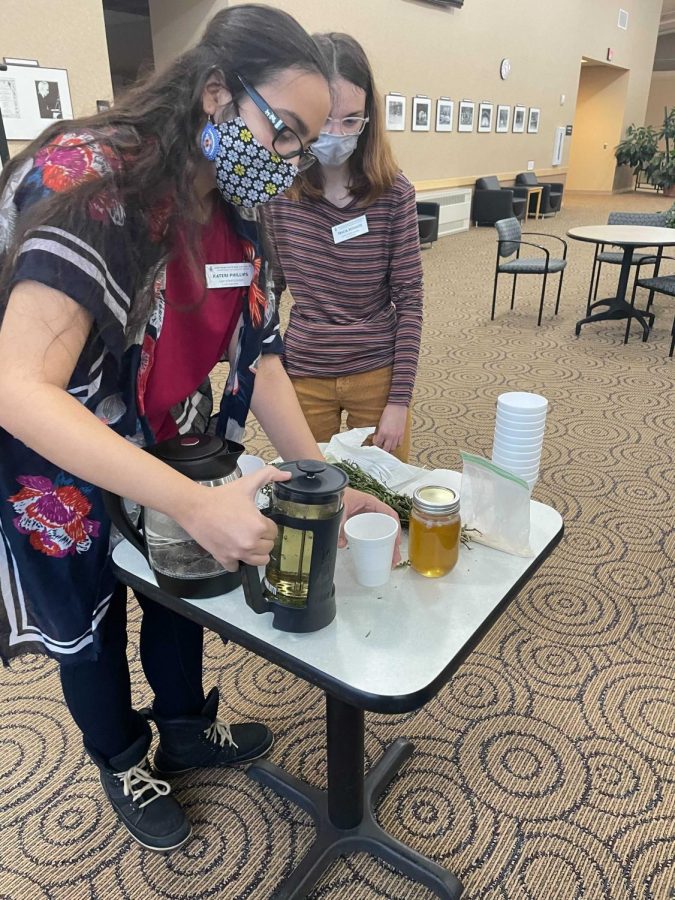Event highlights ties between Indigenous foods culture
Kateri Phillips serves sweet fern tea to participants at the Enlightenment of Indigenous Foods event. The goal of the event was to increase awareness around Native foods and their importance in Native culture.
November 17, 2021
Traditional Indigenous foods, such as corn, beans, squash, quinoa, pumpkin, wild rice and maple syrup, are viewed as sacred due to their medicinal value, health benefits and ties to tribal sovereignty.
These foods provide cultural integration into Indigenous culture and create a sense of closeness with the Native American community.
To highlight these foods, the Enlightenment on Indigenous Foods was an event held by the Student Equity and Engagement Center to create awareness and promote food sovereignty that was held in the Hedgcock building on Monday, Nov. 15.
Sophomore medicinal plant chemistry major Kateri Phillips and senior environmental studies major Tricia Schultz are jumpstart leaders at the SEEC, and they created the presentation on Indigenous foods in light of Native American Heritage Month.
“The event aims to enlighten our audience on Sweet Fern tea and how to properly harvest it [and] extract it into a tea,” said Schultz and Phillips in an email. “We also [aimed] to promote Indigenous foods and explain a few of their medicinal uses.”
Phillips and Schultz talked about the history of Indigenous foods, respecting elders, foraging and harvesting medicinal plants and the importance of sweet fern.
Schultz highlighted three reasons why Indigenous foods are significant — they decrease the risk of developing health issues such as diabetes and obesity, they help with food security and hunger through cultivating and harvesting climate-resilient crops and they bring a diverse group of individuals together to harvest and prepare meals.
Schultz and Phillips focused on the importance of heavily researching plants before foraging for them because the forest is full of imposter plants that are potentially fatal. They also encouraged their audience to get out and explore for these plants, but to be cautious about where to forage them from because things such as roads and trails can negatively impact the plant.
Lastly, Phillips emphasized the exchange of energy and reciprocity that happens when foraging, specifically that the plant provides medicinal qualities and the forager gives thanks for harvesting only what is necessary.
One specific medicine that Phillips and Schultz spoke about was sweet fern.
Sweet fern is a small North American shrub that grows mainly in sandy soils such as well-drained areas to the edges of marshes. Their growing season is from April to June.
Native Americans utilized sweet fern as an anti-itch treatment, an inhalant to clear the lungs, a remedy for stomach issues, as a smudge to repel mosquitos and in religious ceremonies.
Phillips and Schultz prepared sweet fern tea for the audience where they steeped dried stems in boiling water for about five minutes and served with maple sugar which is a sweetener also native to the Great Lakes region.
“The purpose of sharing a traditional tea is to experience the effects of its medicinal purposes and to create a sense of closeness with the Native American community,” said Schultz and Phillips.
The tea can be made from fresh or dried sweet fern. It is a low-allergy medicine that is high in Vitamin C, and the nutrients it provides do not deplete as the plant browns. Sweet fern can be harvested right up until the snow hides it all.
Audience members enjoyed a cup of fresh sweet fern tea, describing its taste as something earthy and green.
“We want students to leave the event with critical thought on Indigenous peoples’ past and present tense and their relationship with food,” said Schultz and Phillips. “Especially medicinal items such as sweet fern.”



























